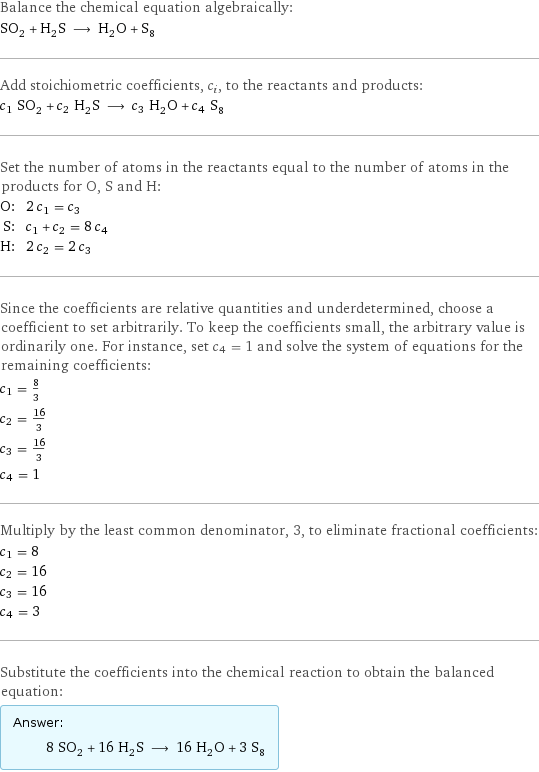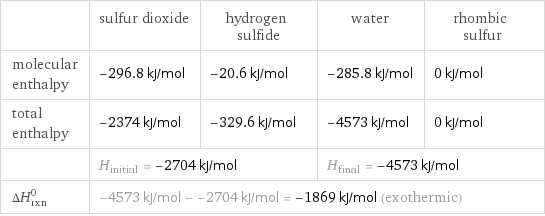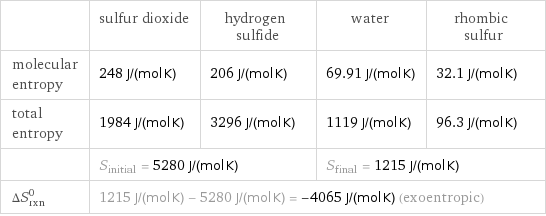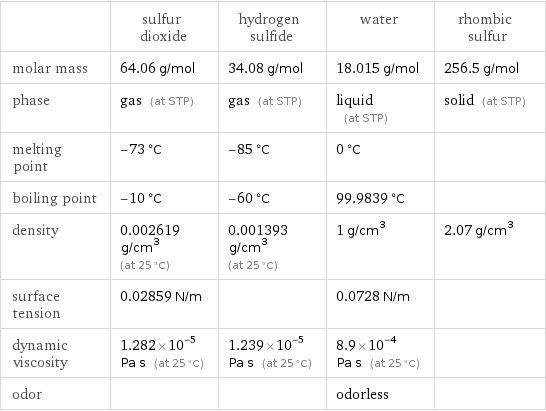Input interpretation

SO_2 sulfur dioxide + H_2S hydrogen sulfide ⟶ H_2O water + S_8 rhombic sulfur
Balanced equation

Balance the chemical equation algebraically: SO_2 + H_2S ⟶ H_2O + S_8 Add stoichiometric coefficients, c_i, to the reactants and products: c_1 SO_2 + c_2 H_2S ⟶ c_3 H_2O + c_4 S_8 Set the number of atoms in the reactants equal to the number of atoms in the products for O, S and H: O: | 2 c_1 = c_3 S: | c_1 + c_2 = 8 c_4 H: | 2 c_2 = 2 c_3 Since the coefficients are relative quantities and underdetermined, choose a coefficient to set arbitrarily. To keep the coefficients small, the arbitrary value is ordinarily one. For instance, set c_4 = 1 and solve the system of equations for the remaining coefficients: c_1 = 8/3 c_2 = 16/3 c_3 = 16/3 c_4 = 1 Multiply by the least common denominator, 3, to eliminate fractional coefficients: c_1 = 8 c_2 = 16 c_3 = 16 c_4 = 3 Substitute the coefficients into the chemical reaction to obtain the balanced equation: Answer: | | 8 SO_2 + 16 H_2S ⟶ 16 H_2O + 3 S_8
Structures

+ ⟶ +
Names

sulfur dioxide + hydrogen sulfide ⟶ water + rhombic sulfur
Reaction thermodynamics
Enthalpy

| sulfur dioxide | hydrogen sulfide | water | rhombic sulfur molecular enthalpy | -296.8 kJ/mol | -20.6 kJ/mol | -285.8 kJ/mol | 0 kJ/mol total enthalpy | -2374 kJ/mol | -329.6 kJ/mol | -4573 kJ/mol | 0 kJ/mol | H_initial = -2704 kJ/mol | | H_final = -4573 kJ/mol | ΔH_rxn^0 | -4573 kJ/mol - -2704 kJ/mol = -1869 kJ/mol (exothermic) | | |
Entropy

| sulfur dioxide | hydrogen sulfide | water | rhombic sulfur molecular entropy | 248 J/(mol K) | 206 J/(mol K) | 69.91 J/(mol K) | 32.1 J/(mol K) total entropy | 1984 J/(mol K) | 3296 J/(mol K) | 1119 J/(mol K) | 96.3 J/(mol K) | S_initial = 5280 J/(mol K) | | S_final = 1215 J/(mol K) | ΔS_rxn^0 | 1215 J/(mol K) - 5280 J/(mol K) = -4065 J/(mol K) (exoentropic) | | |
Equilibrium constant
![Construct the equilibrium constant, K, expression for: SO_2 + H_2S ⟶ H_2O + S_8 Plan: • Balance the chemical equation. • Determine the stoichiometric numbers. • Assemble the activity expression for each chemical species. • Use the activity expressions to build the equilibrium constant expression. Write the balanced chemical equation: 8 SO_2 + 16 H_2S ⟶ 16 H_2O + 3 S_8 Assign stoichiometric numbers, ν_i, using the stoichiometric coefficients, c_i, from the balanced chemical equation in the following manner: ν_i = -c_i for reactants and ν_i = c_i for products: chemical species | c_i | ν_i SO_2 | 8 | -8 H_2S | 16 | -16 H_2O | 16 | 16 S_8 | 3 | 3 Assemble the activity expressions accounting for the state of matter and ν_i: chemical species | c_i | ν_i | activity expression SO_2 | 8 | -8 | ([SO2])^(-8) H_2S | 16 | -16 | ([H2S])^(-16) H_2O | 16 | 16 | ([H2O])^16 S_8 | 3 | 3 | ([S8])^3 The equilibrium constant symbol in the concentration basis is: K_c Mulitply the activity expressions to arrive at the K_c expression: Answer: | | K_c = ([SO2])^(-8) ([H2S])^(-16) ([H2O])^16 ([S8])^3 = (([H2O])^16 ([S8])^3)/(([SO2])^8 ([H2S])^16)](../image_source/7086581e02a74121bdd45be9f7721656.png)
Construct the equilibrium constant, K, expression for: SO_2 + H_2S ⟶ H_2O + S_8 Plan: • Balance the chemical equation. • Determine the stoichiometric numbers. • Assemble the activity expression for each chemical species. • Use the activity expressions to build the equilibrium constant expression. Write the balanced chemical equation: 8 SO_2 + 16 H_2S ⟶ 16 H_2O + 3 S_8 Assign stoichiometric numbers, ν_i, using the stoichiometric coefficients, c_i, from the balanced chemical equation in the following manner: ν_i = -c_i for reactants and ν_i = c_i for products: chemical species | c_i | ν_i SO_2 | 8 | -8 H_2S | 16 | -16 H_2O | 16 | 16 S_8 | 3 | 3 Assemble the activity expressions accounting for the state of matter and ν_i: chemical species | c_i | ν_i | activity expression SO_2 | 8 | -8 | ([SO2])^(-8) H_2S | 16 | -16 | ([H2S])^(-16) H_2O | 16 | 16 | ([H2O])^16 S_8 | 3 | 3 | ([S8])^3 The equilibrium constant symbol in the concentration basis is: K_c Mulitply the activity expressions to arrive at the K_c expression: Answer: | | K_c = ([SO2])^(-8) ([H2S])^(-16) ([H2O])^16 ([S8])^3 = (([H2O])^16 ([S8])^3)/(([SO2])^8 ([H2S])^16)
Rate of reaction
![Construct the rate of reaction expression for: SO_2 + H_2S ⟶ H_2O + S_8 Plan: • Balance the chemical equation. • Determine the stoichiometric numbers. • Assemble the rate term for each chemical species. • Write the rate of reaction expression. Write the balanced chemical equation: 8 SO_2 + 16 H_2S ⟶ 16 H_2O + 3 S_8 Assign stoichiometric numbers, ν_i, using the stoichiometric coefficients, c_i, from the balanced chemical equation in the following manner: ν_i = -c_i for reactants and ν_i = c_i for products: chemical species | c_i | ν_i SO_2 | 8 | -8 H_2S | 16 | -16 H_2O | 16 | 16 S_8 | 3 | 3 The rate term for each chemical species, B_i, is 1/ν_i(Δ[B_i])/(Δt) where [B_i] is the amount concentration and t is time: chemical species | c_i | ν_i | rate term SO_2 | 8 | -8 | -1/8 (Δ[SO2])/(Δt) H_2S | 16 | -16 | -1/16 (Δ[H2S])/(Δt) H_2O | 16 | 16 | 1/16 (Δ[H2O])/(Δt) S_8 | 3 | 3 | 1/3 (Δ[S8])/(Δt) (for infinitesimal rate of change, replace Δ with d) Set the rate terms equal to each other to arrive at the rate expression: Answer: | | rate = -1/8 (Δ[SO2])/(Δt) = -1/16 (Δ[H2S])/(Δt) = 1/16 (Δ[H2O])/(Δt) = 1/3 (Δ[S8])/(Δt) (assuming constant volume and no accumulation of intermediates or side products)](../image_source/feca93d2e8ad16cd94ed4bdeae54fa26.png)
Construct the rate of reaction expression for: SO_2 + H_2S ⟶ H_2O + S_8 Plan: • Balance the chemical equation. • Determine the stoichiometric numbers. • Assemble the rate term for each chemical species. • Write the rate of reaction expression. Write the balanced chemical equation: 8 SO_2 + 16 H_2S ⟶ 16 H_2O + 3 S_8 Assign stoichiometric numbers, ν_i, using the stoichiometric coefficients, c_i, from the balanced chemical equation in the following manner: ν_i = -c_i for reactants and ν_i = c_i for products: chemical species | c_i | ν_i SO_2 | 8 | -8 H_2S | 16 | -16 H_2O | 16 | 16 S_8 | 3 | 3 The rate term for each chemical species, B_i, is 1/ν_i(Δ[B_i])/(Δt) where [B_i] is the amount concentration and t is time: chemical species | c_i | ν_i | rate term SO_2 | 8 | -8 | -1/8 (Δ[SO2])/(Δt) H_2S | 16 | -16 | -1/16 (Δ[H2S])/(Δt) H_2O | 16 | 16 | 1/16 (Δ[H2O])/(Δt) S_8 | 3 | 3 | 1/3 (Δ[S8])/(Δt) (for infinitesimal rate of change, replace Δ with d) Set the rate terms equal to each other to arrive at the rate expression: Answer: | | rate = -1/8 (Δ[SO2])/(Δt) = -1/16 (Δ[H2S])/(Δt) = 1/16 (Δ[H2O])/(Δt) = 1/3 (Δ[S8])/(Δt) (assuming constant volume and no accumulation of intermediates or side products)
Chemical names and formulas

| sulfur dioxide | hydrogen sulfide | water | rhombic sulfur formula | SO_2 | H_2S | H_2O | S_8 Hill formula | O_2S | H_2S | H_2O | S_8 name | sulfur dioxide | hydrogen sulfide | water | rhombic sulfur IUPAC name | sulfur dioxide | hydrogen sulfide | water | octathiocane
Substance properties

| sulfur dioxide | hydrogen sulfide | water | rhombic sulfur molar mass | 64.06 g/mol | 34.08 g/mol | 18.015 g/mol | 256.5 g/mol phase | gas (at STP) | gas (at STP) | liquid (at STP) | solid (at STP) melting point | -73 °C | -85 °C | 0 °C | boiling point | -10 °C | -60 °C | 99.9839 °C | density | 0.002619 g/cm^3 (at 25 °C) | 0.001393 g/cm^3 (at 25 °C) | 1 g/cm^3 | 2.07 g/cm^3 surface tension | 0.02859 N/m | | 0.0728 N/m | dynamic viscosity | 1.282×10^-5 Pa s (at 25 °C) | 1.239×10^-5 Pa s (at 25 °C) | 8.9×10^-4 Pa s (at 25 °C) | odor | | | odorless |
Units
